Rizo Live Newport Performing Arts Center February 8
12 world-famous live art performances by Marina Abramović
The artist often quotes the question she had been asked a lot from 1970 to 2005 (even in America, where such questions are not asked at all): "Why is THIS art?" And she adds that the answer to this question is her whole life.

Indeed, if you read the biography and the track record of a woman about which a lot of people know only sketchy information like "she looked into people's eyes for three months without a break" or "she lost two litres of blood as a result of her performance" - it becomes clear that this is art. Because no layman would ever be able to do that. No layman would even want to do that. So, here's a linear (well, almost linear) biography and the track record of a person usually spoken about either with admiration or misunderstanding. This list proves that it's absolutely unnecessary to set the door of the Federal Security Service on fire or break the law in general in order to become the greatest rebel in art.
The "grandmother of performance art" was born on November 30, 1947, in Belgrade, where she fled from at the age of 29. Information about her childhood is quite unambiguous — the girl had a difficult relationship with her parents whom she rarely saw; Marina's mom and dad were Yugoslav Partisans during the Second World War. However, the artist was born at a time when, the Abramović family became geroes, leaving stray bullets and shelters behind, and, according to Marina herself, began to pay very little attention to her. Still, it was her father who taught the artist her first performance lesson.
At the age of 14, Marina asked her father to buy her oil paints. He fulfilled her request, but his friend decided to play a trick on a teenager. He poured a mixture of paint on the canvas and blew it up with a firecracker. All the participants escaped with a whole skin, and Marina realized for the first time that in art the process could be more important than the result.
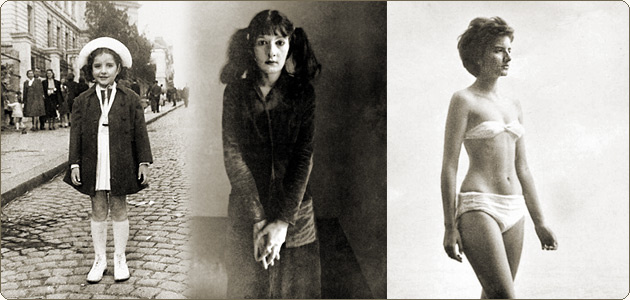
Photo of Marina Abramović. from old.superstyle.ru
"My theory was always that if you have a really tragic childhood, the better the artist you become — if you´re really happy it's different, nothing comes out of happiness. My mother and father were political careerists. They are both national heroes from the second world war — and having a child was not on their agenda, so they just gave me to my grandmother. One day, I was waiting for my grandmother. She was praying in the church, and I saw this thing in the font where you have to dip your finger to cross yourself. I was thinking that if I drank all this water then I would get holy. I was six years old and I stood up on a chair and drank the water. I just got sick," Marina said.
After Marina's father left the family, her mother, bound to raise children on her own, instilled military discipline in the family. The obligation to follow orders without questioning them and not being allowed to leave the house after 10 o'clock at night, oppressed the girl, and, judging by her interviews, Marina carried that feeling through her whole life. They say that she almost died at the same age of 14 when she played Russian roulette with her mother's gun. As a result, having broken free from her mother's control, Marina immediately took up things that would terrify any patriarchal parent.
In 1970, she graduated from the Academy of Fine Arts in Belgrade and began creating performative art. Which would become public, would be discussed by those horrified and weeping — but much later, in 30−40 years.
Balkan Erotic Epic
Marina Abramović was first heard of by many because of her film, which for some time uncontrollably lived on the YouTube channel until the public saw in detail what was depicted there. This performance, acted out by real people, takes place not on stage but in the film which is available for viewing at any time. In non-public places, and typically only in fragments, though.
What's interesting is that Abramović became known to her native audience due to this product of 2006, and then the connoisseurs began to look for her other works — in particular, the performances of the 70's and 90's. Therefore, let's talk about it first.
In the film, Marina talks about how people in her homeland interact with nature and God, mystical and physical phenomena. It is difficult to understand how reliable this story is, but it reveals how the Balkans used to facilitate their wives' labour with their own genitals, and how they cured sick cattle using the same means. Abramović focuses on the fact that in her native culture people's private parts were used in domestic and group village magic as those having special power. For example, "In the Balkans, to make a man love her, a woman would take a small fish and insert it into her vagina and keep it there overnight. The next morning, she would extract the fish, dry it, then grind it into power. By mixing a small amount of this powder with her lover's coffee, it was believed that the man would never leave her," - this is one of the most innocent sentences shown in the 13-minute film, banned almost everywhere due to the number of scenes including nudity. But it can still be found in personal blogs unavailable for under-age children.
Balkan
It's a performance of 1997, dedicated to the memory of those who died in Yugoslavia (or the dead Yugoslavia).
Abramović spent several days, six hours a day, washing bloody bones in front of the public. The number of bones amounted to 1500. Sometimes during the performance, she told about Belgrade and about the fact that she never said that she was from Serbia — the country which no longer existed. The artist was awarded the Golden Lion for Best Artist at the 47th Venice Biennale for Balkan .

Photo: a fragment of the Lips of Thomas performance (1975), source — www.guggenheim.orgThis is the progenitor of all the controversial, resonant and self-injurious perfomances. During this performance, Abramović, having drunk a litre of wine with honey, cut a five-pointed star on her stomach with a razor blade. Then, according to the script, she had to violently whip herself and lay down on a cross made of ice blocks under a suspended space heater. Once her grandmother found Marina unconscious, with her hair burned — she had been rehearsing.
In Belgrade the performance was noticed by very few people, but later she repeated it several times in New York, and that's where it was really appreciated.
Rhythm 0
1974, Studio Morra, Naples. Abramović put on the table 72 objects including a rose, a knife, a loaded gun, scissors, a whip, a flashlight, grapes, bread, apples and a black hat. Any of these objects could be used both to please Abramović, who was standing there still, and to hurt her.
Of course, there were also items for neutral purposes, but the public was interested neither in them nor in the objects intended for bringing pleasure. As soon as people realized that they could use the provided objects in any way they desired and remain unpunished, they gave up control and discovered their real wild side. The description of this performance is often cited in times of social cataclysms associated with the power and influence of the crowd. She stood motionless for six hours, even though she had been cut and nearly shot. After 6 hours, she moved towards the exit and the audience, being afraid that she could strike back. Then she came into the hotel room and saw her first strand of white hair.
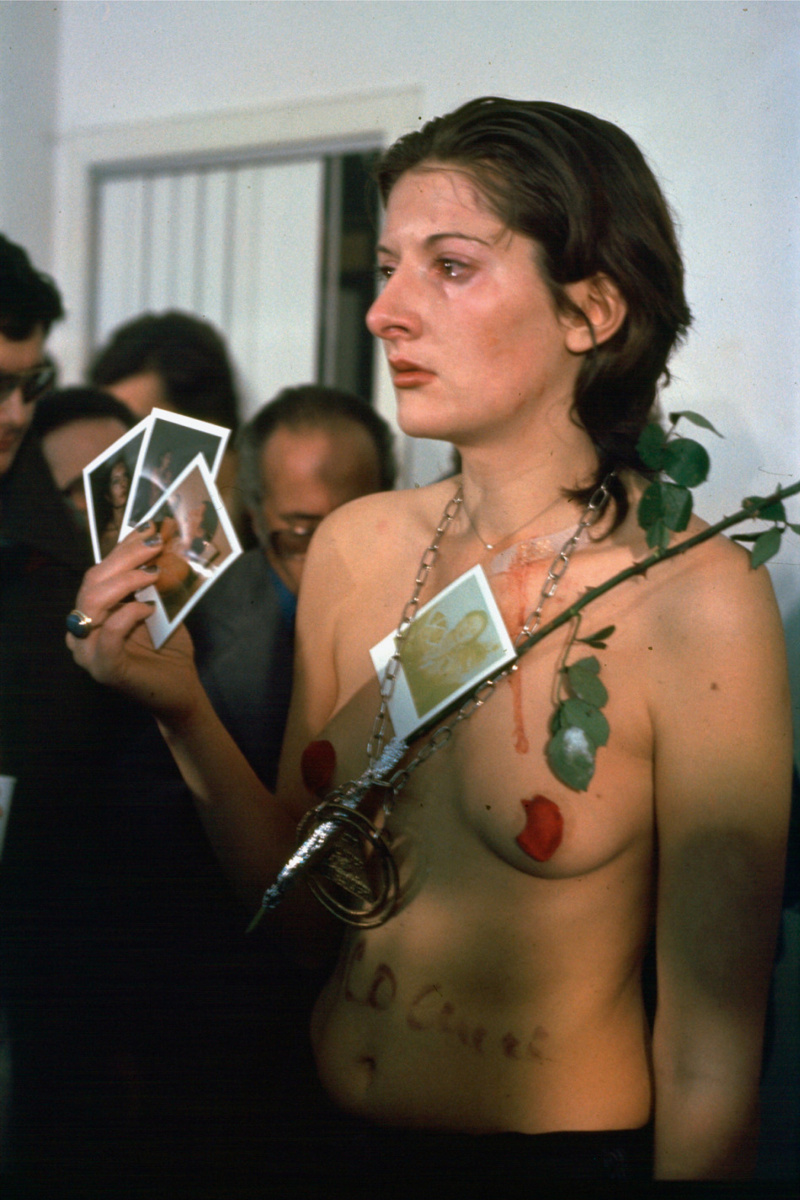
Marina Abramović during the performance Rhythm 0, 1974. Photo: royalacademy.org.uk
Rest Energy
Basically, performances by Marina Abramović can be divided into two major categories — the ones she did on her own and the ones she did with Uwe Laysiepen (Ulay), her long-standing partner and lover.
Rest Energy (1980) is a performance about a close relationship and trust between a man and a woman, during which Ulay was holding the loaded bow with its arrow aimed right at Marina's heart for one and a half minutes. Those were Ulay's biological reactions, behaviour and intentions that Abramović's life depended from at that brief moment filled with emotions. Abramović had to hold the bow firmly in her grasp while leaning backwards and tensing the bow. The microphones were ruthlessly making their breathing and heartbeats audible. Later, Abramović called it one of the most difficult performances in her life.
Imponderabilia
This performance of 1977 was dedicated, oddly enough, to the feelings of a child being born and the pressure that it is experiencing while coming into the world through the birth canal.
What makes it more strange is that Abramović never planned to marry or have children (although she had several consecutive marriages). She and Ulay stood naked at the exhibition's entrance opposite each other, forming a physical visitors had to go through. If truth be told, the labour version is maintained by many information sources, but not by Abramović herself. She explains everything much easier: "anyone who wished to enter the building had to slink through the small gap between us, deciding whom to look at as they passed."
Death Self (1977)
This is another performance about relationships. It is worth saying that every single performance made by Abramović together with Ulay was dedicated to a certain aspect of relationships. Here the conditions for the partners are quite tough: they are continuously kissing, but it's only what the viewers could see.
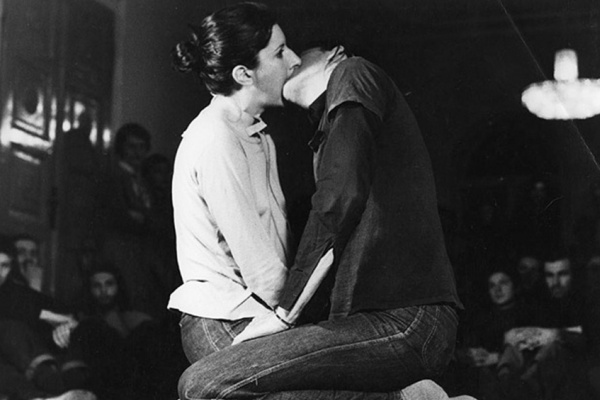
Death Self (Breathing In / Breathing Out). Photo source — bestin.ua
In fact, they couldn't inhale anything else but the exhalation of the other. The participants couldn't feel good after such performance. There is a well-known case when after 17 minutes of such "breathing", both Marina and Ulay fainted simultaneously, (in fact, it's the only case being written about when mentioning this performance).
Relation in Time (1977)
As part of this performance, the partners sat still for 16−17 hours every day of the exhibition. An hour and a half before the audience arrived in the hall, they would sit down back to back and had their hair firmly tied together. It's extremely difficult to sit motionless for such a long time. The position of one of the partners always depended on the position of the other one.
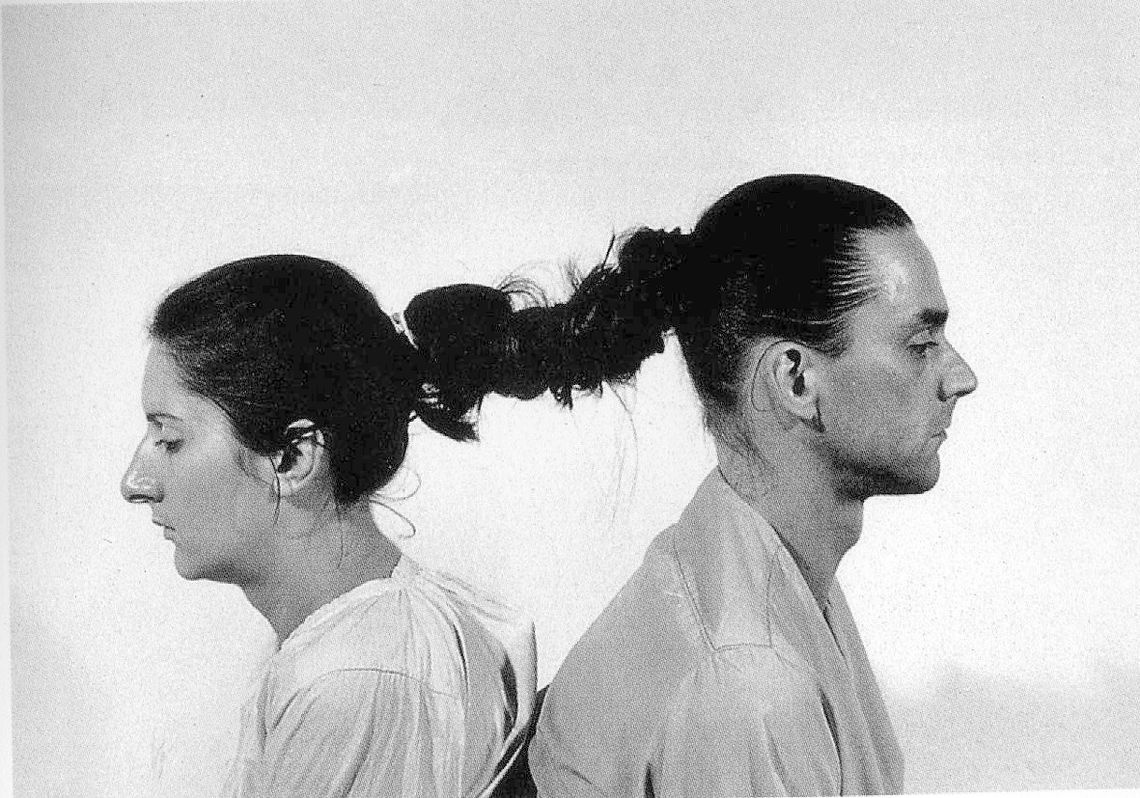
The fragment of the Relation in Time performance. Photo source — moore.edu
Expansion in Space (1977)
Expansion in Space could be performed in different ways, each of them touching upon the open self-harm. Standing back to back, the couple ran face first into the movable (which the audience didn't know about) columns, shoving them with the force of their movement and the weight of their bodies alone — and at some point, after a series of efforts and fails, they succeeded at moving the columns. Crudely speaking, they hit their bodies against a lot of stuff while trying to create art. Against the walls. Each other. Columns… audience… misunderstanding.
The Great Wall (1988)
This performance has quite a sad story, although everything started well. In 1980, Abramović and Ulay decided to get married. And initially the performance was planned to be a wedding and happy one: the couple had to walk the entire length of the Great Wall of China and never separate, but it did not work out. They were waiting for the permission from the Chinese government to visit the Wall. And they got it only 8 years later. During this time, their relationship reached its limits to the point where Ulay's interpreter was pregnant by him. Abramović and Ulay decided to break up, and the performance went nothing as planned.
The former partners walked along the wall starting from different sides, met in the middle, bid adieu and went their separate ways. And that moment may be considered the beginning of the New York period in the work of Marina Abramović, who moved overseas almost immediately after the breakup.
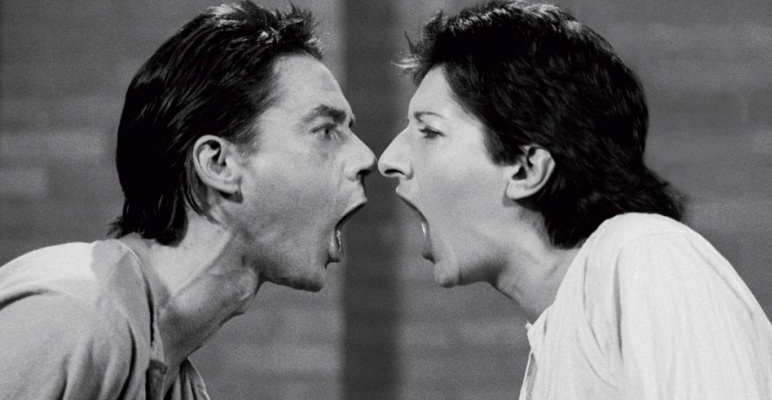
Photo source — styleinsider.com.ua
In general, summing up the Abramović-Ulay duo, it should be mentioned that they created much more joint performances than it is mentioned here. Under their belt, there's also the performance of 1978 called AAA-AAA, where they continuously "produce a long sound at each other" or, putting it more simply, yell at each other… And another performance about the relationship where they run and collide repeatedly into each other, whilst naked… And another one, where they stand still and silent throughout the exhibition, one finger pointing towards the other, nearly touching each other… Alas, it's physically impossible to mention everything these people did before they broke up.

Abramović, Ulay and La Pietà by Michelangelo. Photo source — leilao.catawiki.pt
By the way, another social "performance" was conducted by the ex-couple in 2015, when Ulay suddenly sued his ex-girlfriend and won a 250-thousand-euros-payout against her. The claim looked like this: "She constantly uses my name in her career… and doesn't share." The court agreed with the plaintiff. But it wasn't the end of the story: in the spring of 2018, they announced the joint work on a book of memoirs. Ulay was the initiator of the project.
The House with the Ocean View (2002)
Such a long pause between significant works is explained quite simply: breakup, emigration, poverty and attempts to find her place in a new society. However, when Abramović, already in New York, came out of the shadow, it was quite impressive.
Her performance The House with the Ocean View imitates Buddhist practice. In this case, Marina Abramović's "Zen" consists in spending 12 days under the vigilant supervision of the public, without eating, only drinking water, showering, lying, standing, meditating, and being unable to leave the stage until the end of the performance. The ladders leaning against three rooms had rungs made of large butcher knives.
The Artist Is Present (2010)
This is one of the most famous and often mentioned performances (along with Rhythm 0), preparation for which took weeks. The duration of the performance itself often varied. For example, in MOMA, it lasted 2 months and included 1500 participants and Abramović herself, who managed to physically bear it only because she was allowed to sleep at night. Visitors had to look into the artist's eyes. Here she is, sitting opposite — and everyone has a few minutes to touch the creator's inner world. In this setting, the opposite side can plunge into (as well as abstain from) silently sharing emotions with their vis-a-vis.
However, it was not the performance's main idea that brought it huge publicity. Journalists were shocked when Ulay arrived to take part in it. He and Marina looked at each other for more than 3 minutes, forgiving each other.
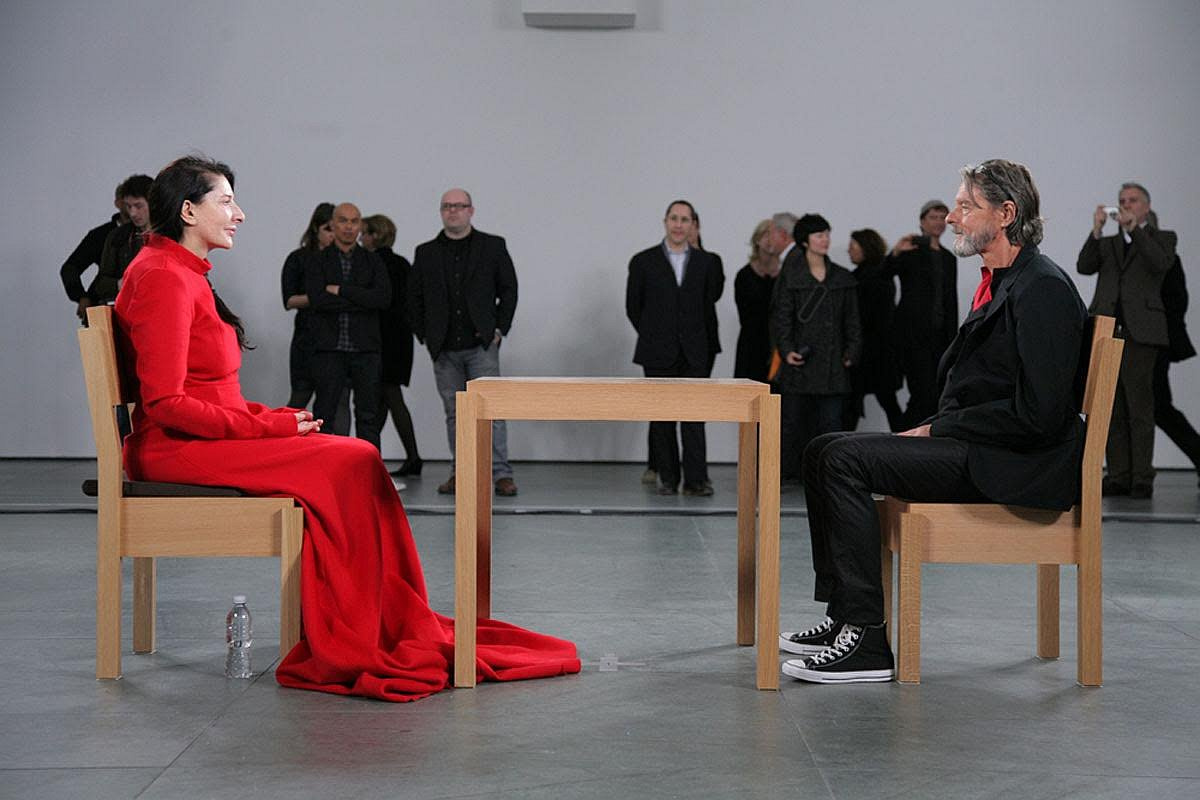
Photo source — www.theartnewspaper.ru
They walked along their "Wall of China" over and over again — tens of thousands kilometres away from it and dozens years after the events associated with it. The ironclad Abramović was moved to tears. But if she had known that Laysiepen would sue her five years later, would she had got into that "staring contest" with him?
The performance was repeated many times in different countries, including Russia (2011). So far this is the last project of Abramović, causing such a powerful resonance. Since 2010, she has been engaged in workshops, training future performance artists, giving interviews, travelling, raising money for the Performance Institute in New York, which, by the way, has a rather vague story: the money has been raised, but there's still no institute.

Photo-portrait from the series The Kitchen, Homage to Saint Therese (2009, photo by Marco Anelli). Saint Teresa of Ávila — a nun who lived in the 16th century — was rumoured to be able to levitate. Abramović is photographed in the abandoned kitchen of the former nunnery La Laboral in Gijón, Spain.
Photo: La Fabrica Gallery, source — banrepcultural.org
Now Abramović is 72 years old, and she is definitely not going to retire.
She surprised everyone with her fresh work Five Stages of Maya Dance, presented in June 2018 at the Masterpiece Design Fair in London: it was not a performance! Abramović showed objects, static work, which, however, created a volatile effect. Relief, volumetric alabaster pieces "changed" depending on the lighting and the position of the viewer. Sometimes portraits seemed to visually "decompose" and resembled extraterrestrial landscapes.
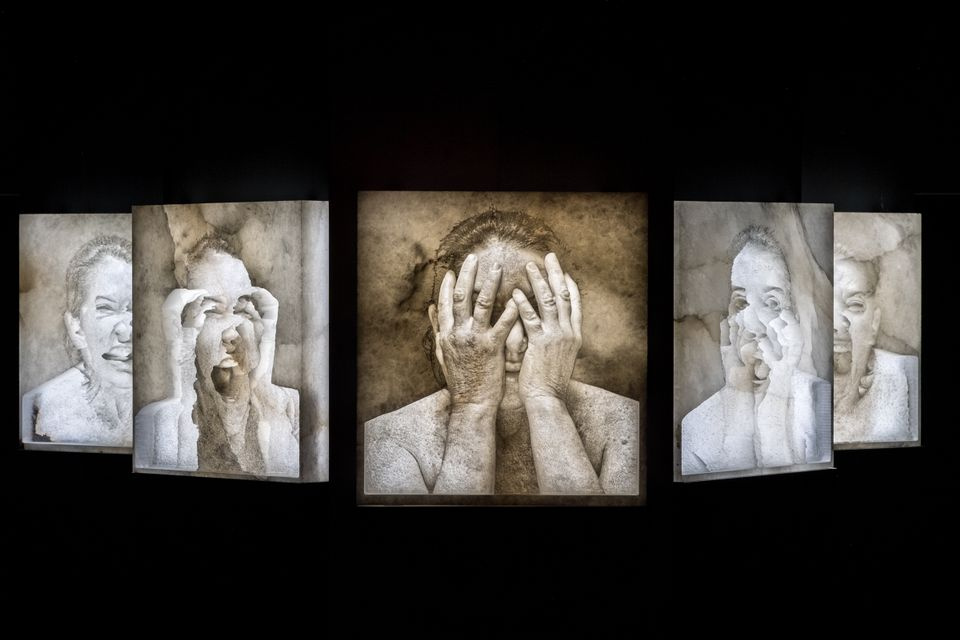
Photo source: www.theartnewspaper.com
"Performance is an immaterial form of art," explained Marina Abramović. "At this point of my life, facing mortality, I hence decided to capture my performance in a more permanent material than just film and photography. I chose alabaster based on its history and properties (luminosity, transparency…). This work as a whole is far from being abstract, but when you immerse in it and move around the pieces they decompose into intricately carved landscapes of alabaster."
Editorial afterword.
Recently, the media have disseminated the news that Marina Abramović will electrify herself with one million volts to light a candle a metre away from her. The striking plot contained time (2020), place (The Royal Academy of Arts in the UK) and a serious technological support — a special machine to shock her, being created by an art-tech company Factum Arte. They say that this idea isn't more dangerous than any other performance by Abramović. Moreover, the artist is going to create a fountain in the form of her body with blood flowing out of it.
The premiere of… opera (!) is also scheduled for the same 2020: her long-standing idea for the film Seven Deaths had to be embodied by worldwide famous directors (Roman Polanski and Alejandro González Iñárritu agreed to do that). As time passed by, Abramović changed her mind: the story of how the singer Maria Callas dies in seven different operas will appear as an opera at The Bavarian State Opera and at The Royal Opera House in Covent Garden, London. Guess who's going to die!
Author: Nata Potiomkina. Title illustration, photo source: kp.ru
Rizo Live Newport Performing Arts Center February 8
Source: https://arthive.com/publications/3518~12_worldfamous_live_art_performances_by_Marina_Abramovi
0 Response to "Rizo Live Newport Performing Arts Center February 8"
Post a Comment